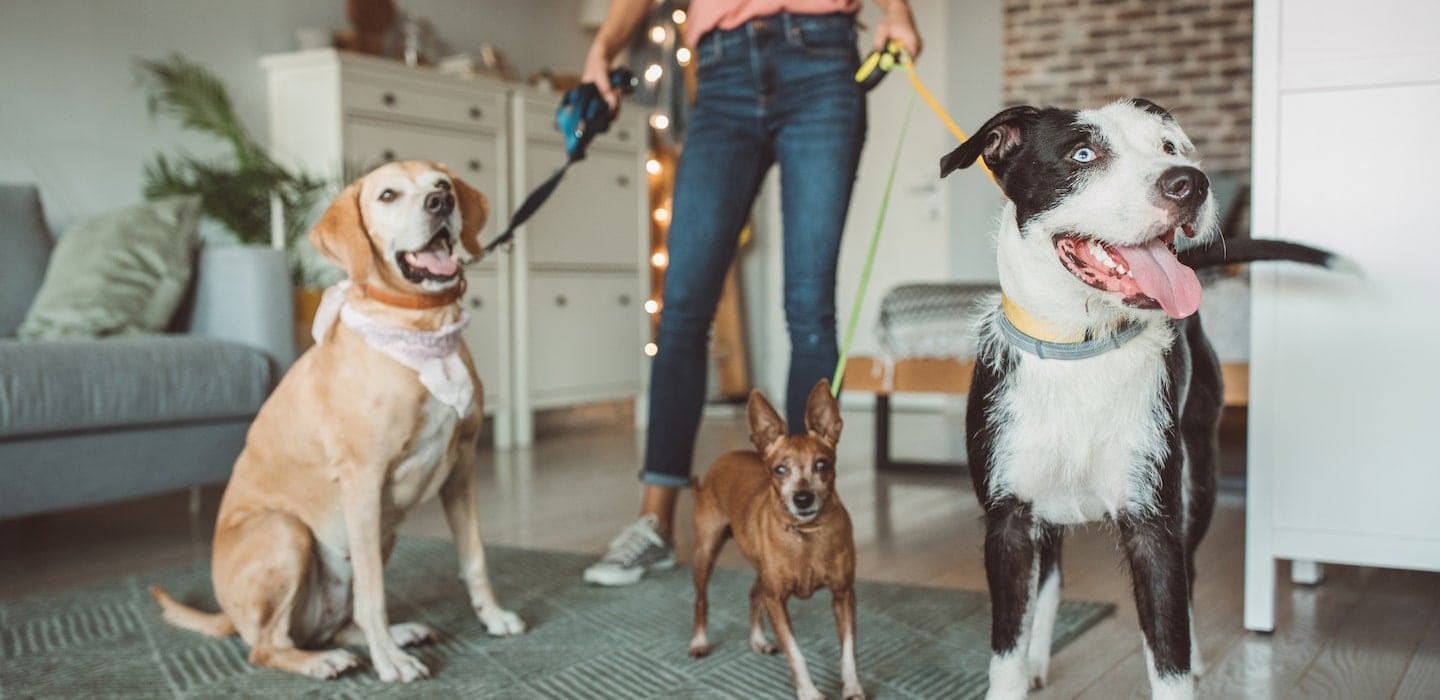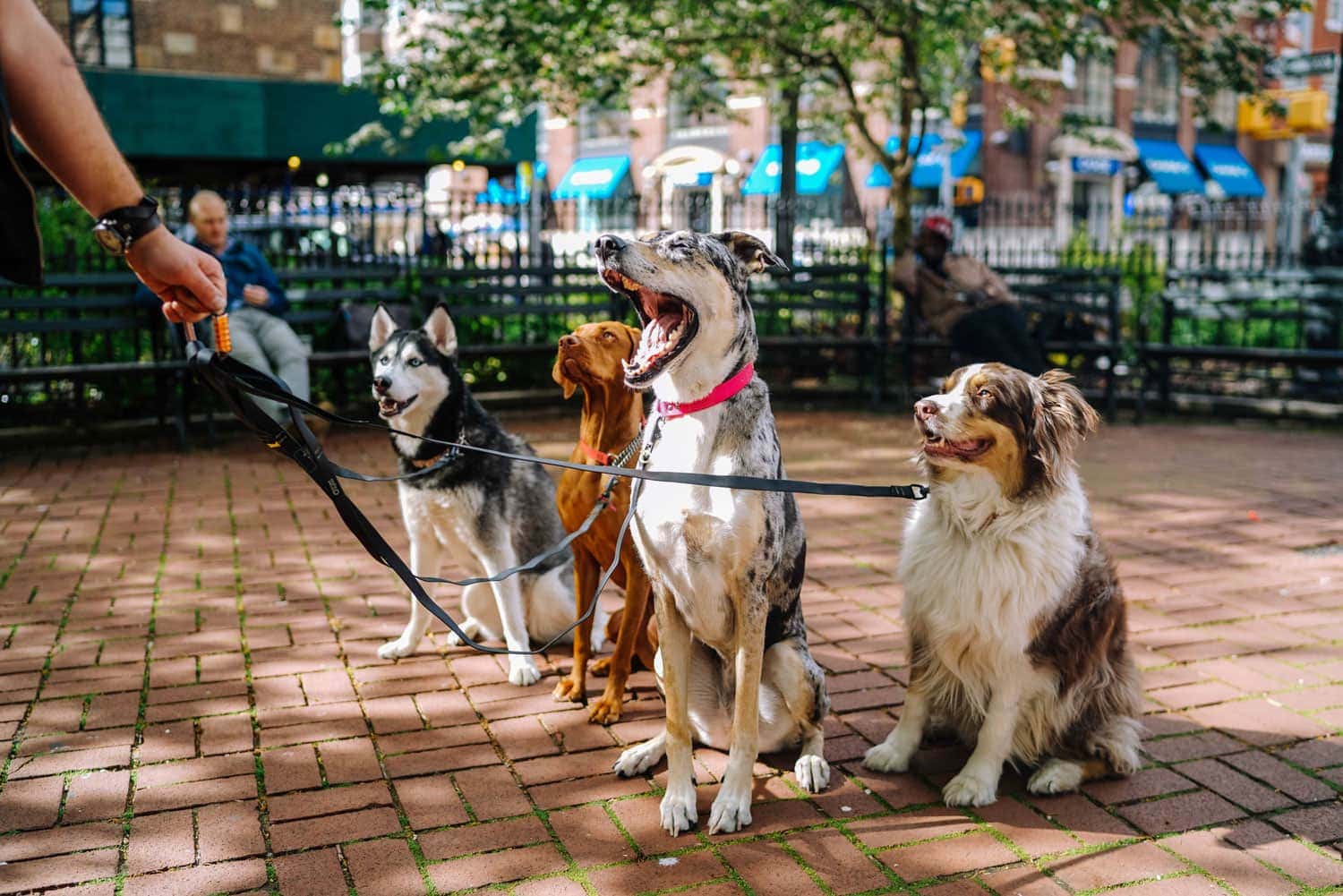If you find more joy in spending time with your furry friends than your human friends (no judgment from us), then working as a dog walker can be incredibly fulfilling.
But knowing how to become a professional dog walker, either as a side hustle or as a full-time career, is a very different breed from occasionally walking your friend’s puppy.
Curious how to become a dog walker? In this guide, we’ll walk you through five important steps to build a sustainable, safe (and fun!) dog walking business.
Step 1: Understand What’s Required of a Dog Walker
For many dog lovers, starting a dog walking business sounds like the perfect job. And while there’s certainly an element of play built into dog walking, it’s not all fun and games all the time. Here are a few considerations to sniff out before committing to a dog walking business:
Are you willing and able to work in all weather conditions?
Dogs need to go on walks no matter what the weather is like. Depending on where you live, this can mean working in rain, snow, extreme heat or cold, or other less-than-ideal conditions.
Do you feel comfortable working with all kinds of dogs?
Some of the dogs you walk will be sweet and well-behaved. Others, not so much. When you’re a dog walker, you’ll need to be able to handle dogs in a variety of sizes, strengths, breeds, and temperaments.
Are you physically able to walk all day, most days of the week?
Being a dog walker means being on your feet all day. Depending on where you’re working, this might also include walking or biking between client residences. You need to feel confident in your ability to be active all day long to do this job. If you answered “yes” to all of the above, then you can move on to planning your business.
Step 2: Determine Your Business Model
There are three main paths toward becoming a professional dog walker: sign up for a dog walking platform or app, work for a local agency, or work for yourself. Each has its own set of pros and cons, described below.
Become a dog walker using an app
App-based platforms, for example Wag and Rover, connect dog walkers with dog owners in their local area. The benefit is that dog walkers don’t have to do the legwork to build their own clientele. These platforms offer dog walkers tons of flexibility, too, allowing them to choose their work schedule, their rates, and the clients they accept. They can also provide other services like house-sitting or doggy daycare.
Luckily, the application process for both Wag and Rover is easy and entirely online. You’ll need to provide some contact information, your relevant experience, and professional referrals, among other details.
The downsides are that some apps require applicants to pass a background check, prove that they’re at least 18 years old, and legally able to work in the U.S. They also take a hefty cut of your earnings.
Also, keep in mind that these agencies may not offer insurance to their dog walkers. You’ll likely need to look into purchasing your own liability insurance and accident and health coverage, which protects you from accidents that may arise when a dog is in your care. (Don’t worry about this step—we’ll get into more details later.)
Become a dog walker with a local dog walking agency
Another option is to work for a small, local dog-walking agency. Typically, these agencies enjoy close relationships with their clients and know their markets quite well. They’re also going to provide more consistent schedules for their dog walkers.
However, you’re still going to sacrifice a significant portion of the money from each walk, and there may not be much room for professional growth on your end.
Start your own dog walking business
Building your own business requires more logistical work, but it provides greater freedom and opportunity as well.
To do so, start by writing a business plan that sets out your long- and short-term goals and an overview of your target market. You also need key financial information, including how much cash you have on hand and how much money you need to launch and run your business. Your business plan should also include the services you’re offering and your price list.
Then, you’ll need to name and structure your business. Your business structure affects your taxes, the paperwork you need to file, and personal liability.1 Next, you must register your business with your state and get a Tax Identification Number through the IRS to legally form your business.
Now, it’s time to pack your work bag.
Step 3: Gather Your Supplies
Professional dog walkers need an arsenal of supplies to keep their clients happy—both the dog and human variety. Here are some supplies you’ll need to stock up on: Leashes and harnesses: It’s up to you or your agency whether you’d like to use the leash and harness provided by the client or your own — but either way, it’s a good idea to have a few extras with you. If you’re walking more than one dog at a time, you’ll need to invest in a multi-dog leash.
Waste bags: Always have more waste bags on hand than you think you need.
Treats: These can be a lifesaver if you’re in a situation where a dog isn’t cooperative. Make sure you ask dog owners if there’s anything their pet can’t eat.
Water dish: Bring a collapsible water dish with you so you can keep dogs hydrated on hot days or during especially long or strenuous walks.
Reflective clothing: Safety is a top concern when you’re walking dogs, especially at night. Wear a reflective vest if you’re walking dogs in the dark and consider purchasing reflective leashes. As soon as you’re ready to walk, begin spreading the word about your business.
Step 4: Market Your Dog Walking Business
If you start your own business, word of mouth will likely become your best leverage for bringing in new clients, as dog walking is inherently based on trust. Still, having an online presence is crucial for modern businesses.
Having a streamlined, easily navigable website that is easy to find on Google makes your business look more professional. It will also help people searching for dog walkers find you online. On your website, be sure to include your contact information, which services you offer, and some positive reviews from happy clients. Also include links to your business’ social media platforms, if you have them.
Having a social media presence is a good way to interact with current and prospective clients. Instagram provides an excellent opportunity for you to show off all the fun your clients’ dogs are having; just be sure to receive your clients’ permission to post photos of their dogs.
Just as you think ahead to grow your business, you must plan to protect your income.
Step 5: Protect Your Business
Dog walking is an inherently risky business, but there are a few steps you can take to protect both your business and your clients.
First, create a contract outlining your terms of service, payment authorization, and cancellation policy. Other important information can include house rules if you’re dog sitting, and emergency protocols in case something goes wrong. Furthermore, request a full medical history of your clients’ dogs. Also consider having your client sign a veterinary release form, which authorizes you to contact a vet in case of emergency.
Despite your best efforts, accidents can happen even to the most careful dog walkers, so you should get general liability insurance. Thimble’s Dog Walking Insurance keeps your business protected from third-party bodily injury and third-party property damage that may occur on the job.
For example: A dog you’re walking bites a stranger that gets a bit too close. In this scenario, your insurance could help cover medical costs to treat their injury.
Or: A dog is really excited after coming back from a walk. You let it off the leash and it zooms around the client’s home, knocking over a table full of expensive glassware. Dog walking insurance can help repay the client.
Plus, we’re adding coverage for animals in your care, custody and control to general liability insurance in more and more states. That means that as a dog walker, you could have coverage for a loss if a client’s pet is injured while in your care.
Getting insured via Thimble is much easier than teaching a dog a trick. Just download the Thimble app or click “Get a Quote” at the bottom of this screen, answer three quick questions, and we’ll instantly generate a quote.
When you’re ready to purchase your policy, we’ll deliver your policy and as many Certificates of Insurance (COI) as you need right to your inbox. The best part? You can get our affordable, on-demand policies by the hour, day, or month, so you only need to pay when you’re on the clock.
Lead the Pack & Start Walking!
Ready to turn your passion for dogs into your dream job? Let’s recap how to become a dog walker:
- Ensure you’re well-suited for this job, as it can be physically demanding and require some special skills.
- Decide whether you’d like to sign up for a dog-walking platform, become a freelancer or employee at a local agency, or build your own dog walking business from scratch.
- Acquire your tools of the trade.
- Get the word out with a website, social media platforms, and good, old-fashioned networking.
- Keep your business protected by creating a contract, requiring all your clients to sign it, and purchasing, at a minimum, general liability insurance.
Follow these five steps, and you’ll be ready to step out on your own as a professional dog walker.
Source:








